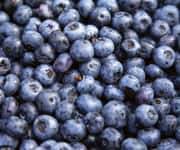Life Extension Magazine®
Pterostilbene is a compound found primarily in blueberries.
It has been the focus of intense longevity research due to its ability to activate three key molecular pathways involved in aging.
What makes pterostilbene unique is how it exhibits its life-extending modes of action.
For example, pterostilbene induces apoptosis (programmed death) in malignant cells.1 Yet it exerts the opposite effect in the cardiovascular system, where it decreases the risk of atherosclerosis by protecting endothelial cells.2
This multipurpose compound also helps prevent the dangerous buildup of cellular waste products that interfere with biological activity throughout the body.
Pterostilbene, a calorie restriction mimetic, is proving itself to be an important workhorse in the fight against aging.
Pterostilbene Mimics Calorie Restriction

One mechanism by which calorie restriction has been shown to beneficially extend lifespan is by “turning on” genes directly related to long-term survival.3 Scientists have been intrigued to find that pterostilbene mimics many of the same broad preventive and therapeutic properties of calorie restriction.
In fact, pterostilbene impacts multiple antiaging factors involved in cardiovascular,4 hematologic,5 inflammatory,6 metabolic,7 and neurological disorders.8 Preclinical studies suggest that pterostilbene acts as a potent antitumor compound in multiple malignancies.9
One reason why pterostilbene is so effective at promoting longevity is that, similar to calorie restriction, it activates antiaging molecular pathways. And multiple studies confirm pterostilbene’s remarkable antiaging effects.10-15
Cell and animal studies have shown that pterostilbene can extend the lifespan of various animal models of human longevity by regulating three major pathways linked to longevity: mTOR, AMPK, and sirtuins.
Let’s look at each individually.
Anti-Aging Pathway #1: mTOR
A molecular complex called mammalian target of rapamycin (mTOR) is currently a major focus of pharmacological research to slow aging—and for good reason. So far, reducing the expression of mTOR has been shown to extend lifespan across multiple species. Laboratory-bred mice whose expression of mTOR has been reduced to about 25% enjoy an approximate 20% increase in median lifespan.16
mTOR is a cellular signaling pathway that serves as a central regulator for cell growth, metabolism, survival, and proliferation.17 This pathway is responsible for controlling many of the processes that use or generate large amounts of energy and nutrients.18 When mTOR signaling goes awry, it triggers numerous harmful events, including those linked to a variety of cancers.19-21
Abnormal mTOR activation is a contributor to many of the chronic diseases of aging.21-23 Scientists are aggressively seeking pharmaceutical approaches to lower the activity of mTOR.
Pterostilbene (as well as other CR mimetics and calorie restricted diets) has been found to naturally inhibit the mTOR pathway.24 This reduction in mTOR provides a powerful way of regulating cellular growth and metabolism, and combating some of the primary factors involved in aging and disease.
Anti-Aging Pathway #2: AMPK
While pterostilbene has been shown to naturally inhibit the mTOR pathway, it has been found to beneficially activate a separate important pathway associated with an increase in lifespan and a decrease in degenerative disease. Called AMPK (short for adenosine monophosphate-activated protein kinase), this cellular energy sensor regulates the ways our bodies use and transform energy.
When we’re young, higher levels of activated AMPK are present, which helps protect us against many conditions, including obesity and diabetes. But with time, AMPK activation decreases, which can lead to weight gain and accelerated aging.25
By increasing AMPK activation through the use of various nutritional compounds including pterostilbene, we can achieve a reduction in many of the destructive factors of aging, enabling our cells to return to their youthful vitality. Preclinical research shows that enhanced AMPK activity is associated with an approximate 20% increase in lifespan.26 It has also been shown to shrink body-fat stores, lower blood sugar and lipid levels, and suppress chronic inflammation—all of which are key indicators of a reduction in the aging process.25,27
Activating AMPK can also help protect against Alzheimer’s disease because it suppresses the formation of beta-amyloid plaque and tau tangles,28 two of the primary markers of this neurodegenerative disease. It has also been found to limit oxidative stress that leads to hypertension,29 increase cell survival during hypoxia (oxygen deprivation),30 and promote autophagy to reduce memory impairment.31
Activating AMPK is a critical component for warding off degenerative disease. Pterostilbene helps activate this important longevity pathway.
Anti-Aging Pathway #3: Sirtuins
Pterostilbene regulates the activation of key anti-aging molecules known as silent information regulators (SIR), or sirtuins. Sirtuins act across multiple cellular pathways that regulate gene expression, aging, DNA repair, metabolism and apoptosis.32-34 Studies have also examined the vital role that sirtuins play in maintaining telomere length.35
These are critical longevity factors, since shortened telomeres are associated with reduced lifespan.
In a cell study model of ischemia-reperfusion injury, pterostilbene was found to protect heart cells from apoptosis by stimulating the activity and enhancing the expression of sirtuin-1. Study investigators concluded that pterostilbene could be used clinically to alleviate heart muscle injury due to a heart attack.36
What You Need to Know
 |
Pterostilbene: A Powerful Compound Found in Blueberries
- Pterostilbene, the lifespan-extending compound found in blueberries, has emerged from resveratrol’s shadow as a CR mimetic with remarkably diverse antiaging effects.
- It possesses a dynamic mode of action that shifts depending upon where it works in the body and which pathological condition it’s targeting.
- Pterostilbene impacts key molecular pathways involved in extending lifespan.
- Pterostilbene works synergistically with resveratrol to provide complementary health and longevity benefits.
Eliminating Cellular Garbage
Another way pterostilbene can extend lifespan and ameliorate age-related diseases is by preventing the buildup of age-related cellular waste products.37 These aggregates of damaged and cross-linked proteins, known as lipofuscin, are detrimental to normal cell functions.37,38
The rate of lipofuscin formation is closely related to the level of cellular oxidative stress. Studies suggest that lipofuscin may be involved in the earliest stages of Alzheimer’s disease by causing mitochondrial dysfunction and by activating an innate immune response that can damage neurons.39
The body is equipped with small garbage disposals within cells called lysosomes that are designed to remove harmful lipofuscin.40 When lysosomes stop working properly, it leads to the accumulation of lipofuscin. The progressive accumulation of this cellular debris is considered to be a reliable marker of aging.41
In addition to accelerating the aging process, these junk-laden cells contribute to neurodegenerative diseases like Alzheimer’s and Parkinson’s, and they have been found in vascular lesions in the retina.42,43
By preventing the buildup of cellular garbage, pterostilbene helps keep the body’s systems running more smoothly and efficiently—an important factor in maintaining youthful vigor while also preventing age-related diseases.
Pterostilbene’s Synergistic Effects

Pterostilbene is especially effective when combined with other specific antiaging compounds and CR (calorie restriction) mimetics.
One of the most significant relationships is with resveratrol. Pterostilbene and resveratrol are both stilbene compounds and are structurally related.
Pterostilbene and resveratrol naturally occur together in certain varieties of berries and grapes.44,45 Both compounds have been shown to mimic the anti-aging effects of caloric restriction, and multiple studies have confirmed their synergistic health benefits.46-48
Resveratrol is known for its potential ability to combat cancer and diabetes, while protecting against cardiovascular disease and Alzheimer’s. Pterostilbene affects longevity-related molecular pathways “downstream” from the sites activated by resveratrol, thereby increasing the antiaging effects. Together, these effects make these two compounds especially beneficial when taken together.
Combining pterostilbene with resveratrol has been shown to be a beneficial therapy for treating estrogen receptor-alpha-negative breast cancer cells when combined with standard-of-care antihormonal therapy.49
Additionally, combined treatment with pterostilbene and resveratrol has been shown to significantly and synergistically inhibit the growth of triple-negative breast cancer cells, a type of breast cancer that is especially aggressive and difficult to treat.48 This cell study found no harmful effects of the treatment on healthy control breast cells, demonstrating the safety and effectiveness of the two compounds.
Pterostilbene’s established ability to work in concert with other CR mimetics provides an opportunity to take advantage of the compound’s synergistic lifespan-extending effects.
Potent Brain Benefits

Blueberries are the primary dietary source of pterostilbene. Study after study has shown that consuming blueberries can prevent and mitigate age-related cognitive disorders,50,51 and higher intakes of blueberries have been found to reduce the rate of cognitive decline.52
While blueberries contain numerous compounds that contribute to these cognitive benefits, pterostilbene is one of the most important contributing factors. Studies have shown that pterostilbene can improve cognition in rats. It has also been shown to help prevent the loss of the neurotransmitter dopamine from memory centers in aged rats.53
This is an example of how pterostilbene can battle the effects of age-related diseases.
Summary

Multiple studies have shown that the health and longevity benefits of consuming blueberries are largely due to the presence of pterostilbene.11 Although pterostilbene is structurally similar to the well-known red wine molecule resveratrol, the two CR mimetics work in complementary ways to boost lifespan extension.
Pterostilbene works on critical molecular pathways involved in lifespan extension, and it has been shown to work synergistically with resveratrol.
Pterostilbene has a wide range of preventive and therapeutic properties that allow it to beneficially impact factors involved in cardiovascular disease, neurodegenerative diseases, metabolic disorders, and cancer.
After spending years in the shadow of its more widely known and researched molecular cousin, resveratrol, pterostilbene has emerged as a powerful CR mimetic.
One can obtain standardized potencies of pterostilbene in supplemental form, often combined with resveratrol.
If you have any questions on the scientific content of this article, please call a Life Extension® Wellness Specialist at 1-866-864-3027.
References
- McCormack D, McFadden D. Pterostilbene and cancer: current review. J Surg Res. 2012;173(2):e53-61.
- Zhang L, Zhou G, Song W, et al. Pterostilbene protects vascular endothelial cells against oxidized low-density lipoprotein-induced apoptosis in vitro and in vivo. Apoptosis. 2012;17(1):25-36.
- Alcain FJ, Villalba JM. Sirtuin activators. Expert Opin Ther Pat. 2009;19(4):403-14.
- Gan W, Dang Y, Han X, et al. ERK5/HDAC5-mediated, resveratrol-, and pterostilbene-induced expression of MnSOD in human endothelial cells. Mol Nutr Food Res. 2016;60(2):266-77.
- Mikstacka R, Rimando AM, Ignatowicz E. Antioxidant effect of trans-resveratrol, pterostilbene, quercetin and their combinations in human erythrocytes in vitro. Plant Foods Hum Nutr. 2010;65(1):57-63.
- Liu J, Fan C, Yu L, et al. Pterostilbene exerts an anti-inflammatory effect via regulating endoplasmic reticulum stress in endothelial cells. Cytokine. 2016;77:88-97.
- Grover JK, Vats V, Yadav SS. Pterocarpus marsupium extract (Vijayasar) prevented the alteration in metabolic patterns induced in the normal rat by feeding an adequate diet containing fructose as sole carbohydrate. Diabetes Obes Metab. 2005;7(4):414-20.
- Yang Y, Wang J, Li Y, et al. HO-1 Signaling Activation by Pterostilbene Treatment Attenuates Mitochondrial Oxidative Damage Induced by Cerebral Ischemia Reperfusion Injury. Mol Neurobiol. 2016;53(4):2339-53.
- Benlloch M, Obrador E, Valles SL, et al. Pterostilbene Decreases the Antioxidant Defenses of Aggressive Cancer Cells In Vivo: A Physiological Glucocorticoids- and Nrf2-Dependent Mechanism. Antioxid Redox Signal. 2016;24(17):974-90.
- Shukitt-Hale B. Blueberries and neuronal aging. Gerontology. 2012;58(6):518-23.
- McCormack D, McFadden D. A review of pterostilbene antioxidant activity and disease modification. Oxid Med Cell Longev. 2013;2013:575482.
- Meyer MJ, Mosely DE, Amarnath V, et al. Metabolism of 4-hydroxy-trans-2-nonenal by central nervous system mitochondria is dependent on age and NAD+ availability. Chem Res Toxicol. 2004;17(9):1272-9.
- Uysal U, Seremet S, Lamping JW, et al. Consumption of polyphenol plants may slow aging and associated diseases. Curr Pharm Des. 2013;19(34):6094-111.
- Coban J, Dogan-Ekici I, Aydin AF, et al. Blueberry treatment decreased D-galactose-induced oxidative stress and brain damage in rats. Metab Brain Dis. 2015;30(3):793-802.
- Estrela JM, Ortega A, Mena S, et al. Pterostilbene: Biomedical applications. Crit Rev Clin Lab Sci. 2013;50(3):65-78.
- Wu JJ, Liu J, Chen EB, et al. Increased mammalian lifespan and a segmental and tissue-specific slowing of aging after genetic reduction of mTOR expression. Cell Rep. 2013;4(5):913-20.
- Laplante M, Sabatini DM. mTOR signaling at a glance. J Cell Sci. 2009;122(Pt 20):3589-94.
- Laplante M, Sabatini DM. mTOR signaling in growth control and disease. Cell. 2012;149(2):274-93.
- Kalender A, Selvaraj A, Kim SY, et al. Metformin, independent of AMPK, inhibits mTORC1 in a rag GTPase-dependent manner. Cell Metab. 2010;11(5):390-401.
- Hoeffer CA, Klann E. mTOR signaling: at the crossroads of plasticity, memory and disease. Trends Neurosci. 2010;33(2):67-75.
- Zoncu R, Efeyan A, Sabatini DM. mTOR: from growth signal integration to cancer, diabetes and ageing. Nat Rev Mol Cell Biol. 2011;12(1):21-35.
- Sakuma K, Yamaguchi A. Molecular mechanisms in aging and current strategies to counteract sarcopenia. Curr Aging Sci. 2010;3(2):90-101.
- Sudarsanam S, Johnson DE. Functional consequences of mTOR inhibition. Curr Opin Drug Discov Devel. 2010;13(1):31-40.
- Zhang L, Cui L, Zhou G, et al. Pterostilbene, a natural small-molecular compound, promotes cytoprotective macroautophagy in vascular endothelial cells. J Nutr Biochem. 2013;24(5):903-11.
- Salminen A, Kaarniranta K. AMP-activated protein kinase (AMPK) controls the aging process via an integrated signaling network. Ageing Res Rev. 2012;11(2):230-41.
- Stenesen D, Suh JM, Seo J, et al. Adenosine nucleotide biosynthesis and AMPK regulate adult life span and mediate the longevity benefit of caloric restriction in flies. Cell Metab. 2013;17(1):101-12.
- Towler MC, Hardie DG. AMP-activated protein kinase in metabolic control and insulin signaling. Circ Res. 2007;100(3):328-41.
- Salminen A, Kaarniranta K, Haapasalo A, et al. AMP-activated protein kinase: a potential player in Alzheimer’s disease. J Neurochem. 2011;118(4):460-74.
- Cheng PW, Ho WY, Su YT, et al. Resveratrol decreases fructose-induced oxidative stress, mediated by NADPH oxidase via an AMPK-dependent mechanism. Br J Pharmacol. 2014;171(11):2739-50.
- Sheng B, Liu J, Li GH. Metformin preconditioning protects Daphnia pulex from lethal hypoxic insult involving AMPK, HIF and mTOR signaling. Comp Biochem Physiol B Biochem Mol Biol. 2012;163(1):51-8.
- Zhu Z, Yan J, Jiang W, et al. Arctigenin effectively ameliorates memory impairment in Alzheimer’s disease model mice targeting both beta-amyloid production and clearance. J Neurosci. 2013;33(32):13138-49.
- Greiss S, Gartner A. Sirtuin/Sir2 phylogeny, evolutionary considerations and structural conservation. Mol Cells. 2009;28(5):407-15.
- Kang H, Jung JW, Kim MK, et al. CK2 is the regulator of SIRT1 substrate-binding affinity, deacetylase activity and cellular response to DNA-damage. PLoS One. 2009;4(8):e6611.
- Yamagata K, Kitabayashi I. Sirt1 physically interacts with Tip60 and negatively regulates Tip60-mediated acetylation of H2AX. Biochem Biophys Res Commun. 2009;390(4):1355-60.
- Zhang B, Chen J, Cheng AS, et al. Depletion of sirtuin 1 (SIRT1) leads to epigenetic modifications of telomerase (TERT) gene in hepatocellular carcinoma cells. PLoS One. 2014;9(1):e84931.
- Guo Y, Zhang L, Li F, et al. Restoration of sirt1 function by pterostilbene attenuates hypoxia-reoxygenation injury in cardiomyocytes. Eur J Pharmacol. 2016;776:26-33.
- Dong Y, Guha S, Sun X, et al. Nutraceutical interventions for promoting healthy aging in invertebrate models. Oxid Med Cell Longev. 2012;2012:718491.
- Wilson MA, Shukitt-Hale B, Kalt W, et al. Blueberry polyphenols increase lifespan and thermotolerance in Caenorhabditis elegans. Aging Cell. 2006;5(1):59-68.
- Moreira PI, Carvalho C, Zhu X, et al. Mitochondrial dysfunction is a trigger of Alzheimer’s disease pathophysiology. Biochim Biophys Acta. 2010;1802(1):2-10.
- Terman A, Gustafsson B, Brunk UT. The lysosomal-mitochondrial axis theory of postmitotic aging and cell death. Chem Biol Interact. 2006;163(1-2):29-37.
- Georgakopoulou EA, Tsimaratou K, Evangelou K, et al. Specific lipofuscin staining as a novel biomarker to detect replicative and stress-induced senescence. A method applicable in cryo-preserved and archival tissues. Aging (Albany NY). 2013;5(1):37-50.
- Youssef SA, Capucchio MT, Rofina JE, et al. Pathology of the Aging Brain in Domestic and Laboratory Animals, and Animal Models of Human Neurodegenerative Diseases. Vet Pathol. 2016;53(2):327-48.
- Catita J, Lopez-Luppo M, Ramos D, et al. Imaging of cellular aging in human retinal blood vessels. Exp Eye Res. 2015;135:14-25.
- Paul S, DeCastro AJ, Lee HJ, et al. Dietary intake of pterostilbene, a constituent of blueberries, inhibits the beta-catenin/p65 downstream signaling pathway and colon carcinogenesis in rats. Carcinogenesis. 2010;31(7):1272-8.
- Schmidlin L, Poutaraud A, Claudel P, et al. A stress-inducible resveratrol O-methyltransferase involved in the biosynthesis of pterostilbene in grapevine. Plant Physiol. 2008;148(3):1630-9.
- Timmers S, Konings E, Bilet L, et al. Calorie restriction-like effects of 30 days of resveratrol supplementation on energy metabolism and metabolic profile in obese humans. Cell Metab. 2011;14(5):612-22.
- Barger JL, Kayo T, Vann JM, et al. A low dose of dietary resveratrol partially mimics caloric restriction and retards aging parameters in mice. PLoS One. 2008;3(6):e2264.
- Kala R, Shah HN, Martin SL, et al. Epigenetic-based combinatorial resveratrol and pterostilbene alters DNA damage response by affecting SIRT1 and DNMT enzyme expression, including SIRT1-dependent gamma-H2AX and telomerase regulation in triple-negative breast cancer. BMC Cancer. 2015;15:672.
- Kala R, Tollefsbol TO. A Novel Combinatorial Epigenetic Therapy Using Resveratrol and Pterostilbene for Restoring Estrogen Receptor-alpha (ERalpha) Expression in ERalpha-Negative Breast Cancer Cells. PLoS One. 2016;11(5):e0155057.
- Yang H, Jiang Y. Research progress of bioactive constituents, absorption, metabolism, and neuroprotective effects from blueberry. Wei Sheng Yan Jiu. 2010;39(4):525-8.
- Cherniack EP. A berry thought-provoking idea: the potential role of plant polyphenols in the treatment of age-related cognitive disorders. Br J Nutr. 2012;108(5):794-800.
- Malin DH, Lee DR, Goyarzu P, et al. Short-term blueberry-enriched diet prevents and reverses object recognition memory loss in aging rats. Nutrition. 2011;27(3):338-42.
- Joseph JA, Fisher DR, Cheng V, et al. Cellular and behavioral effects of stilbene resveratrol analogues: implications for reducing the deleterious effects of aging. J Agric Food Chem. 2008;56(22):10544-51.

